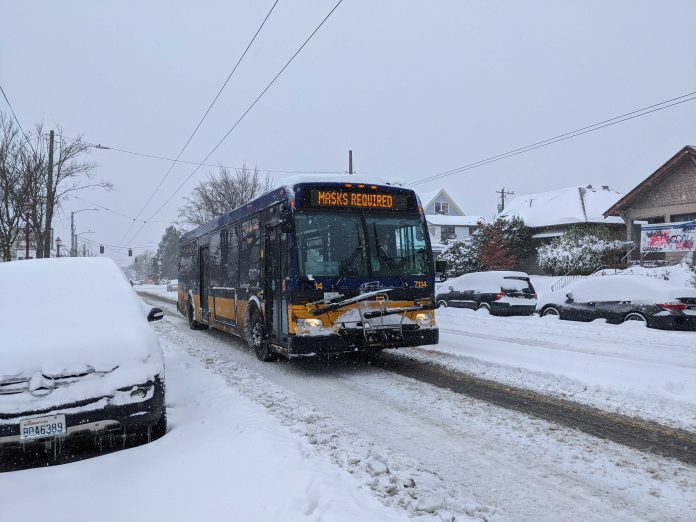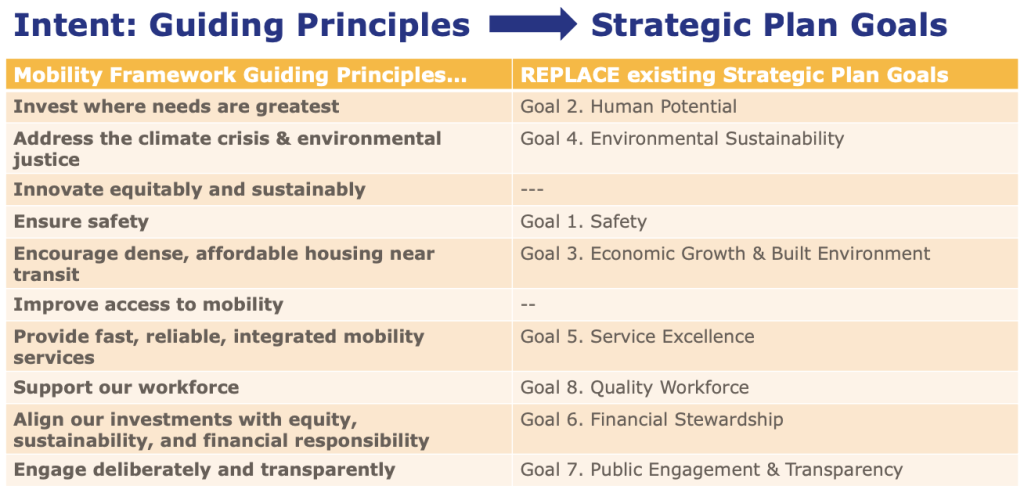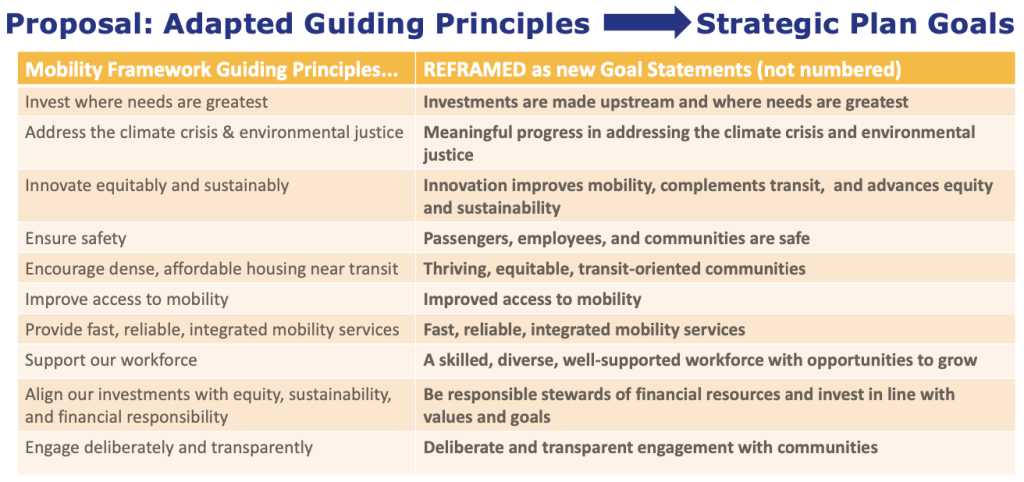Updates to King County Metro’s key policy documents have been delayed due to Covid-induced impacts, but the agency hopes to complete them this year to chart the agency’s service future. The trio of key policy documents include the Strategic Plan for Public Transportation, Service Guidelines, and Metro Connects. Each document addresses different aspects of how the agency plans and implements service across the county’s bus network over the near- and long-term. Informing much of the updates are the Mobility Framework recommendations that were developed in partnership with the Regional Equity Cabinet. Implementing the longer-term goals of a more expansive, frequent bus network, however, will take more funding that has yet to materialize.
Updates to the Strategic Plan for Transportation
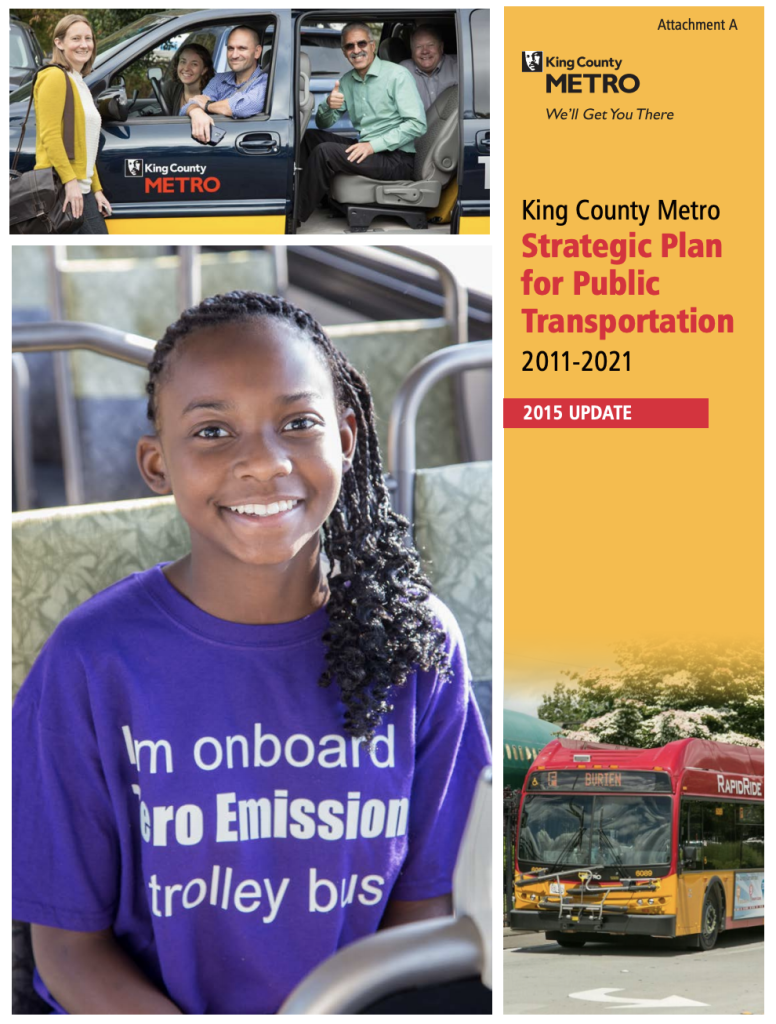
The Strategic Plan for Public Transportation was last updated in 2016 and provides transportation goals, outlines strategies and objectives to implement the goals, and contains specific performance measures to assess success with the plan. Eight goals are outlined in the plan, including: safety, human potential, economic growth and the built environment, environmental sustainability, service excellence, financial stewardship, public engagement and transparency, and quality workforce.
The 2021 update to the plan will focus on aligning the goals and policies with the Mobility Framework’s guiding principles and recommendations. Substantive revisions will also incorporate new information on the King County Water Taxi (which was folded into Metro recently), climate goals, innovative transportation, and equitable transit-oriented communities’ objectives. In addition, Metro will pursue simplification of performance measures and ensure that they align with key policy drivers.
Right now, there are 68 performance measures that get reported out to the county council every two years. Metro wants these to be less static and more useful to the public and policymakers. To address this, Metro plans to launch an online dashboard by July–similar to The Dash that was rolled out late last year to measure operational metrics related to Covid–that will be regularly updated and the number of performance measures will be reduced by about half.
In an effort to revamp the plan goals, Metro intends to use the Mobility Framework’s guiding principles that happen to largely overlap with existing goals in the plan. There are several cases (i.e. “improve access to mobility” and “innovate equitably and sustainably”) where the incorporated guiding principles will be fully new goals in the plan. The guiding principles are being recast somewhat so that they are full actionable goal statements, but the overall intent is the same.
Updates to Metro Connects
Metro Connects, the long-range vision for system growth, was designed to expand bus service by 70% between 2015 and 2040. This functionally means huge injections of service hours, redesigning the bus network, and upgrading many existing corridors to a RapidRide standard. The plan, however, is not fully funded and has recently become significantly delayed due to financial impact from the pandemic.
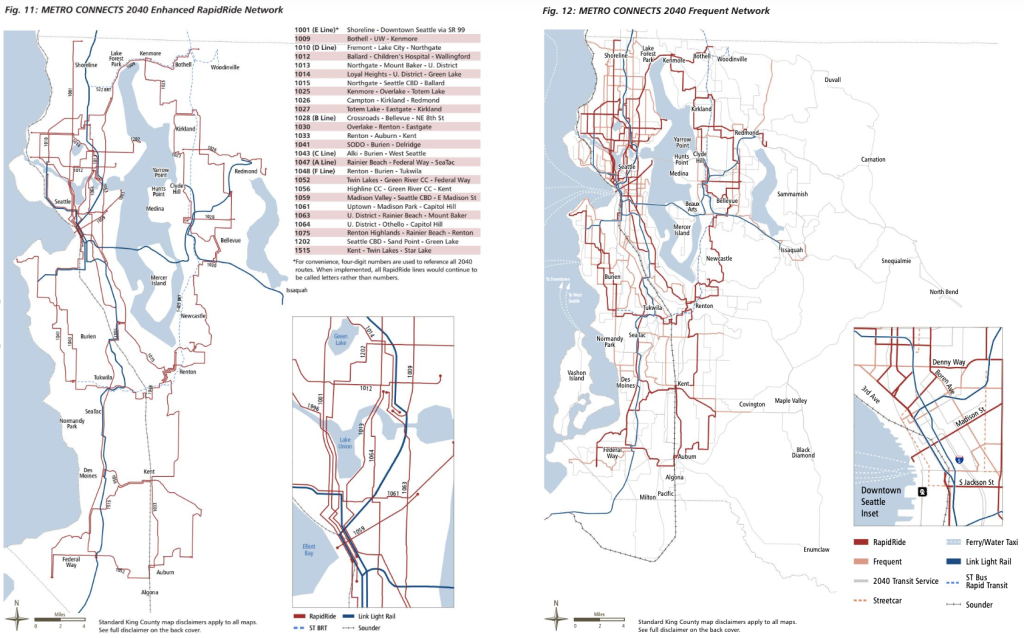
In updating the Metro Connects plan, the agency will move the time horizon for full implementation to 2050, reevaluate the RapidRide network, and address equity gaps. The update process will also address several other key aspects, including:
- A revision to the rolling six-year “interim” implementation plan;
- Updated assumptions for inflation, population growth, and influence of Sound Transit 3–that was passed by voters only several months before Metro Connects was adopted in 2017;
- Incorporation of goals like equity and climate from the Mobility Framework;
- Clarification of community partnership opportunities and expectations;
- Additions of new sections that touch on new policies and programs like electrification and King County Water Taxi;
- How policy and the public engagement process will be used for plan implementation (i.e., service and capital investments);
- New financial projections of program costs and information on how communities can help realize the plan;
- Revisions to the long-range service map; and
- Acknowledgement of Metro as a mobility agency (e.g., vanpools, community van, Via to Transit), not just a traditional transit agency.
Updates to the Service Guidelines
The next policy document, the King County Metro Service Guidelines, deals with how the agency evaluates and reports on service performance and how investments in service are prioritized to facilitate ridership growth. Each year, Metro delivers a system evaluation that fully analyzes route-by-route performance and highlights where service needs are in the system. Four priority areas are identified in the guidelines (i.e., reducing crowding, improving reliability, service growth, and route productivity) and are used to make decisions about service changes, whether that means increases or decreases of service on individual routes.
In the update, Metro plans to prioritize equity in making service investments and revise priorities to align them with the Mobility Framework. Along with these revisions, Metro also plans to incorporate objectives of Metro Connects into the guidelines, establish a new set of guidelines specific to the King County Water Taxi, examine lower-performing routes for their environmental impacts (i.e., greenhouse gas emissions), and outline corresponding land use types that support particular service types.
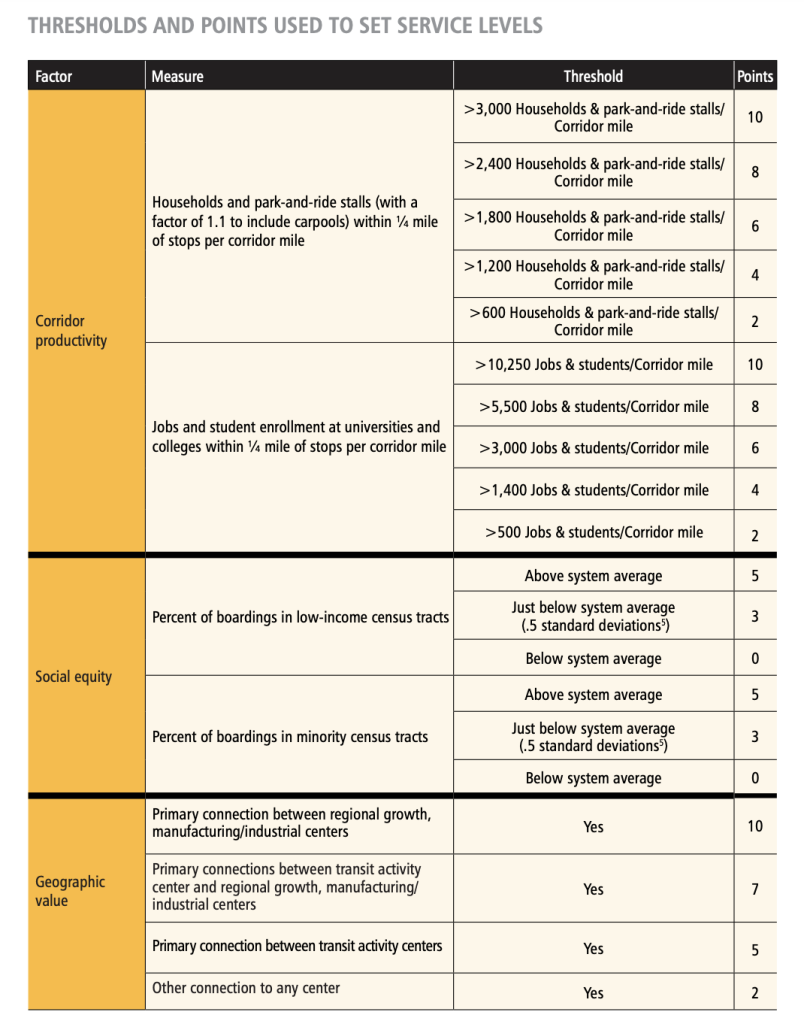
In determining where service growth (Priority 3) goes, Metro uses three general factors to assess priority. The factors are equity, productivity, and geographic value. Each factor has a specific definition in the guidelines.
- Equity is defined by using two factors that measure boardings from low-income census tracts and boardings from minority census tracts. Metro plans to redefine this by looking at five factors from census data, including race, income, disability, foreign born populations, and limited English-speaking populations.
- Productivity is defined on a potential basis by measuring the potential ridership market based upon nearby housing units, park-and-ride stalls, students, and jobs to transit corridors. When computed on an individual route basis, actual ridership is measured in annual system evaluations as rides per platform hour and passenger miles per platform mile. These metrics highlight the efficiency of routes and how full they are. Metro plans to add factors that look specifically at access to low- and moderate-income jobs.
- Geographic value is defined as the value of transit corridors connecting regionally-designated centers by the Puget Sound Regional Council and Metro-identified transit activity centers. These include Regional Growth Center, Manufacturing/Industrial Centers, and other places that Metro values for transit activity.
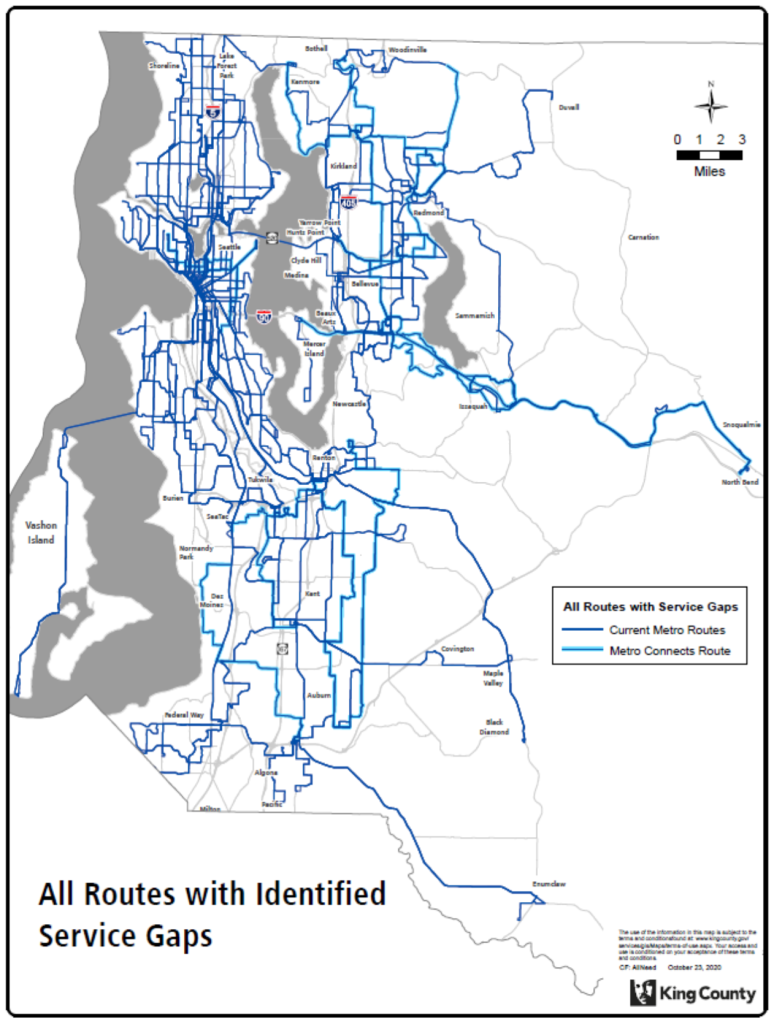
Covid has meant Metro slashing service, particularly on peak-hour commuter routes. But despite the pandemic impacts, the need for transit remains strong. Metro has identified extensive service gaps across the network that will need to be addressed in the years ahead and require additional funding to achieve. Underpinning this are both the service guidelines and Metro Connects directing where needs are unmet.
Right now, there is a network-wide need of about 400,000 more annual service hours based upon the service guidelines. This is in line with many recent years’ needs. Under the Metro Connects rolling six-year interim network time horizon, the service guidelines suggest that the need rises up to 1.5 million more annual service hours.
Outside the pandemic, the identified levels of additional service would induce much higher levels of system ridership. Additional service hours on the Metro Connects level also mean that more communities would be reached or connected by transit.
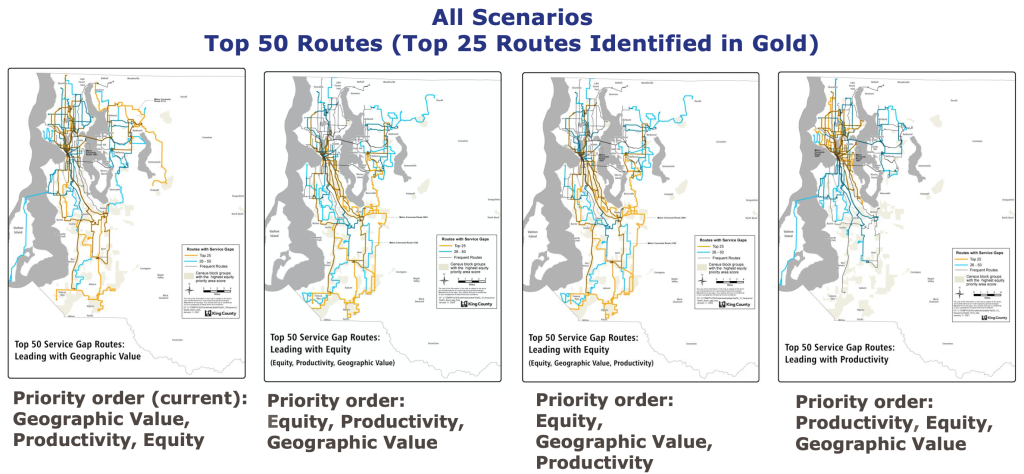
Depending upon how priority values are ordered, the routes with the highest investment needs are notably different. Placing equity as a higher priority results in maps that identify Southeast Seattle and South King County routes as the most in-need routes for investment. Conversely, focusing productivity as the highest priority pushes routes in Seattle, particularly in North Seattle, Capitol Hill, and Southeast Seattle, higher up as in-need routes for investment.
A final set of updated policy documents will be transmitted to the Metropolitan King County Council in July. Final adoption is expected thereafter.
Stephen is a professional urban planner in Puget Sound with a passion for sustainable, livable, and diverse cities. He is especially interested in how policies, regulations, and programs can promote positive outcomes for communities. With stints in great cities like Bellingham and Cork, Stephen currently lives in Seattle. He primarily covers land use and transportation issues and has been with The Urbanist since 2014.


